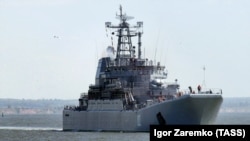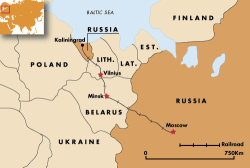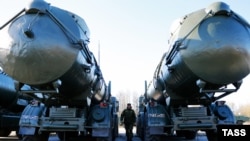Russia is pouring troops and weapons -- including missiles capable of carrying nuclear warheads -- into its western exclave of Kaliningrad at such a rate that the region is now one of Europe's most militarized places.
A NATO official, writing to RFE/RL on condition of anonymity, said that Moscow is stationing "thousands of troops, including mechanized and naval infantry brigades, military aircraft, modern long-range air defense units and hundreds of armored vehicles in the territory."
The military activity in Kaliningrad, which has no land connection to Russia and which borders EU members Lithuania and Poland, has raised alarms in Vilnius and Warsaw that can be clearly heard in Brussels and Washington.
"They're making quite big military exercises in the Kaliningrad district [which is] very, very close to our neighborhood," says Andrius Kubilius, a former Lithuanian prime minister. "So of course we are worried about such military developments very close to our borders."
In part due to such concerns, NATO this month is carrying out military maneuvers in Poland and the Baltic States, a U.S. military convoy recently travelled across Eastern and Central Europe in a show of the defense alliance's commitment to protect the region, and Washington is reportedly debating whether to store heavy military equipment in several Baltic and Eastern European countries bordering Russia.
The Kaliningrad region, which lies along the Baltic Sea in what was once East Prussia, has long held strategic value.
'Forward-Operating Base'
Annexed from Germany in 1945, Kaliningrad was a closed military zone during the Soviet era, meaning only someone with special permission could get in.
It is now home to Russia's Baltic Sea Fleet, as well as the Chernyakhovsk and Donskoye air bases, with thousands of Russian troops stationed there.
As the confrontation with the West heats up, Russia is finding Kaliningrad the "obvious place" to deploy more military hardware, explains Dmitry Gorenburg, a Russian military expert at the CNA Corporation think tank in Arlington, Virginia.
Kaliningrad also serves as the likely starting point for the numerous reports of Russian military activity over Baltic airspace and in the Baltic Sea, Gorenburg tells RFE/RL.
"From Kaliningrad you can just go right out and you're there; there's Sweden, Poland, Germany's not that far away," Gorenburg explains. "So, it's almost like you can set it up as a forward-operating base without leaving your own country's territory."
Gorenburg says the growing military role of the Baltic Fleet contrasts with its more peaceful past.
"It's right near where all the main shipyards are. It was a place where they tested a lot of the new ships," Gorenburg says. "Its main mission prior to the crisis was mostly focused on sort of coastal protection kind of stuff. There really wasn't a lot of military activity in the Baltic Sea until quite recently."
According to NATO and regional analysts, one of the main worries for the West is whether Moscow has permanently stationed Iskander missiles in Kaliningrad.
Iskanders are capable of carrying conventional and nuclear warheads and have a range of 400 kilometers -- meaning if they were stationed in Kaliningrad many European cities, including Berlin and Warsaw, would be in their range.
In the past, the Kremlin has used the threat of deploying Iskanders in Kaliningrad as a sort of bargaining chip.
In 2008, Moscow said it would station the missiles there if Washington went ahead with plans to build components of a U.S. missile defense shield in Poland and the Czech Republic.
In 2009, U.S. President Barack Obama scrapped those plans.
The Iskander missiles were reported to have been deployed, at least temporarily, when Russian President Vladimir Putin ordered "snap" -- meaning with no prior notification to the West -- military drills in Kaliningrad in December 2014 and March 2015.
The size of the drills has been nothing short of impressive, with some 9,000 troops and 55 naval ships taking part in the December 5-10 exercises.
In Poland, the potential threat posed by the Iskander missiles in part prompted Warsaw to decide to upgrade its air-defense system, according to Pavel Fleischer, a research fellow at Warsaw's Casimir Pulaski Foundation.
"Recently, we just finished the procurement process for a new air-defense system, and we chose the [U.S.] Patriot [Air and Missile Defense] System," Fleischer tells RFE/RL. "So, we think our capabilities will be increased during the next couple of years."
In March, Poland said it was seeking to obtain Tomahawk missiles for submarines that Poland is planning to purchase by 2030.
Fears Of 'Provocation'
In Lithuania, the main rail link between Kaliningrad and Russia proper, leaders are concerned the Kremlin may orchestrate a "provocation" in the exclave to escalate tensions, according to Kubilius.
"We are afraid of any kind of possible provocations on transit routes, both railways, or gas pipeline, or electricity transit routes, which can be organized in order to have some type of pretext from Moscow's side, for Russia's side, to begin some aggressive actions," explains Kubilius, the leader of Lithuania's Homeland Union center-right party.
In May, Lithuania joined Latvia and Estonia in announcing they were seeking a permanent NATO presence on their soil to counter increased Russian military action.
All three countries have significant Russian minorities and fear Kremlin moves to inflame tensions there after the pro-Russian uprising in eastern Ukraine.
NATO said it would study the proposal.
Vladimir Chizhov, Russia's ambassador to the EU, said the request to NATO was motivated by "local politics rather than a genuine security situation."
Amid growing Baltic unease, The New York Times reported on June 13 that Washington was "poised to station battle tanks, infantry fighting vehicles and other heavy weapons for as many as 5,000 American troops in several Baltic and Eastern European countries."
Russia in part justifies its actions in Kaliningrad by painting the West as the aggressor, pointing to NATO expansion to former Soviet satellite states, and to the deployment of NATO troops and hardware closer to Russian borders.
The New York Times report on the planned U.S. stationing of heavy military equipment in the Baltics and Eastern Europe set off alarms at the Kremlin.
A Russian Defense Ministry official said the planned U.S. action would amount to "the most aggressive step by the Pentagon and NATO" since the Cold War.
Although he did not mention Kaliningrad, General Yuri Yakubov said on June 15 that "Russia would be left with no other option but to boost its troops and forces on the western flank."
In a sign that it was not an idle threat, Putin announced the next day that Russia would add more than 40 new intercontinental ballistic missiles to its nuclear arsenal this year.


















